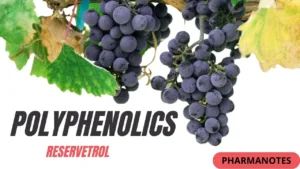Occurrence and characteristic features of Polyphenolics

Polyphenolics
Polyphenolics, also known as polyphenols, are a class of naturally occurring compounds found in plants. They are characterized by the presence of multiple phenolic (aromatic) rings and are widely distributed in the plant kingdom. Polyphenolics encompass a diverse group of compounds, including flavonoids, phenolic acids, tannins, and stilbenes, among others.
Occurrence:
Polyphenolics are found in various plant-based food sources, including fruits, vegetables, grains, nuts, seeds, and beverages such as tea, coffee, and wine. Different plant species contain varying types and concentrations of polyphenolic compounds. For example, flavonoids are abundant in citrus fruits, berries, and cocoa, while phenolic acids are found in coffee, whole grains, and vegetables.
Characteristic Features:
1. Phenolic Rings: Polyphenolics have one or more phenolic rings, which are aromatic hydrocarbon rings with a hydroxyl (-OH) group attached.
2. Antioxidant Activity: One of the key characteristics of polyphenolics is their antioxidant activity. They possess the ability to scavenge and neutralize harmful free radicals in the body, thereby protecting cells from oxidative damage.
3. Color and Flavor: Polyphenolics often contribute to the color and flavor of plant-based foods. For example, anthocyanins, a type of flavonoid, impart vibrant red, purple, and blue hues to berries and other colorful fruits.
4. Health Benefits: Polyphenolics have been extensively studied for their potential health benefits. They are associated with numerous physiological effects, including anti-inflammatory, anti-cancer, anti-diabetic, neuroprotective, and cardiovascular-protective properties. These effects are attributed to their antioxidant, anti-inflammatory, and other bioactive properties.
5. Bioavailability and Metabolism: The bioavailability and metabolism of polyphenolics vary depending on their chemical structure and food matrix. Some polyphenols are readily absorbed in the small intestine, while others reach the large intestine, where they can be metabolized by the gut microbiota into bioactive compounds.
6. Synergistic Effects: Polyphenolics often work synergistically with other compounds present in the same plant source. For example, the combination of flavonoids and vitamin C in fruits provides enhanced antioxidant activity compared to either compound alone.
It’s important to note that the specific characteristics and functions of polyphenolics can vary widely within the class due to the diverse range of compounds it encompasses.
Reservetrol
Resveratrol is a specific polyphenolic compound that belongs to the stilbenes subgroup. It is found in various plants, particularly in the skins of grapes and in red wine. Here are the occurrence and characteristic features of resveratrol:
Occurrence:
1. Grapes: Resveratrol is naturally present in grapes, especially in their skins. Red grapes contain higher amounts of resveratrol compared to green grapes.
2. Red Wine: Resveratrol is also found in red wine, as it is extracted from grape skins during the fermentation process. Red wine is often considered a significant dietary source of resveratrol.
3. Other Plant Sources: Resveratrol is also found in other plants, including berries (such as blueberries and cranberries), peanuts, and knotweed (Polygonum cuspidatum).
Characteristic Features:
1. Antioxidant Activity: Resveratrol exhibits potent antioxidant properties, helping to neutralize free radicals and reduce oxidative stress in the body.
2. Anti-Inflammatory Effects: Resveratrol has been shown to possess anti-inflammatory properties, which can help combat inflammation in various tissues and organs.
3. Cardiovascular Benefits: Resveratrol has gained attention for its potential cardiovascular benefits. It may help improve heart health by reducing cholesterol levels, lowering blood pressure, and inhibiting platelet aggregation.
4. Potential Anti-Cancer Properties: Resveratrol has been studied for its potential anti-cancer effects. It may exhibit anti-tumor properties and inhibit the growth of cancer cells. However, more research is needed to fully understand its mechanisms and efficacy.
5. Anti-Aging Effects: Resveratrol has been associated with anti-aging effects in some studies. It may activate certain genes and proteins that are involved in cellular longevity and DNA repair.
6. Estrogenic Activity: Resveratrol has been found to exhibit estrogenic activity, which means it can bind to estrogen receptors in the body. This characteristic may have implications for hormone-related conditions and health.
7. Bioavailability and Metabolism: Resveratrol’s bioavailability is relatively low, meaning that a significant portion of ingested resveratrol is rapidly metabolized and eliminated from the body. However, research is being conducted to enhance its bioavailability through various formulations and delivery methods.
It’s worth noting that while resveratrol has shown promising effects in various studies, much of the research has been conducted in laboratory and animal models. Further clinical research is necessary to determine its full potential and therapeutic applications in humans.
